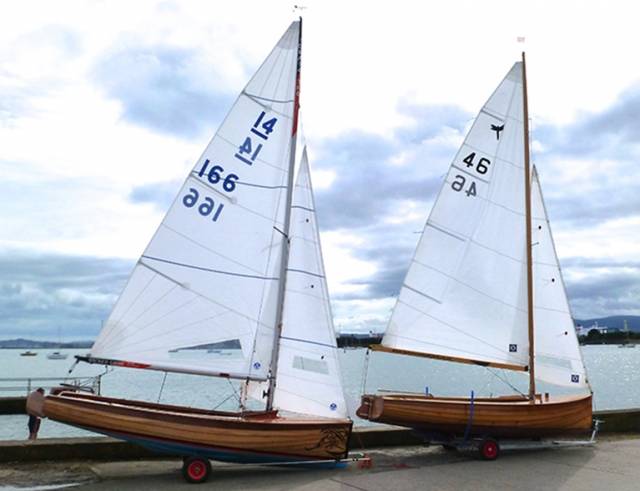A two-day celebration in a coastal suburb of Dublin to mark the 70th birthday of a 14ft One-Design sailing dinghy class may not seem an event of major significance in an island nation which can trace its recreational sailing history back for 300 years and more. Yet in becoming involved at Clontarf Yacht & Boat Club in the IDRA 14 Class’s honouring of its three-score-years-and-ten last Sunday, W M Nixon found he was getting a special insight into what makes us tick both as a sailing community, and as part of Irish society as a whole.
Clontarf is a place which is comfortable with itself. It’s not Dublin’s poshest suburb. It doesn’t want to be. It just wants to be itself - an unassuming pleasantly leafy place with a south-facing waterfront, a place which is convenient to the city yet clearly has a healthy identity of its own. And Clontarf is quietly confident that, in its combination with its many and various clubs, organizations, and societies, it possesses a higher level of social capital than other smoother suburbs where the social structures might seem more glossy, but genuine depth of community may be lacking.
Clontarf Yacht & Boat Club is typical of this. For sailors from elsewhere, its setup at first seems challenging. For starters, you can only get sailing for half of the time. In the other half, the tide is out. They’ll tell you this has the benefit of providing alternative time for the local cricket and rugby clubs. Yet despite the apparent tidal inconvenience, every year there seem to be more boats on the drying moorings than ever before. And when the tide comes in, they really do go sailing, unlike other non-tidal clubs, where the continuous availability of sailing makes people more picky in choosing their weather.

Another Clontarf factor which strangers find difficult is the existence of a busy road through the club’s dinghy park. Or at least it goes straight across the short distance from the dinghy park to the slipway. It’s something which the founders hadn’t planned. When Clontarf Yacht & Boat Club was set up in 1875, it established its HQ in a charming little shoreside farmhouse called Belvedere which was not only pleasantly south-facing, but had an uninterrupted and unrivalled view to the Dublin and Wicklow Mountains across the inner waters of Dublin Bay.
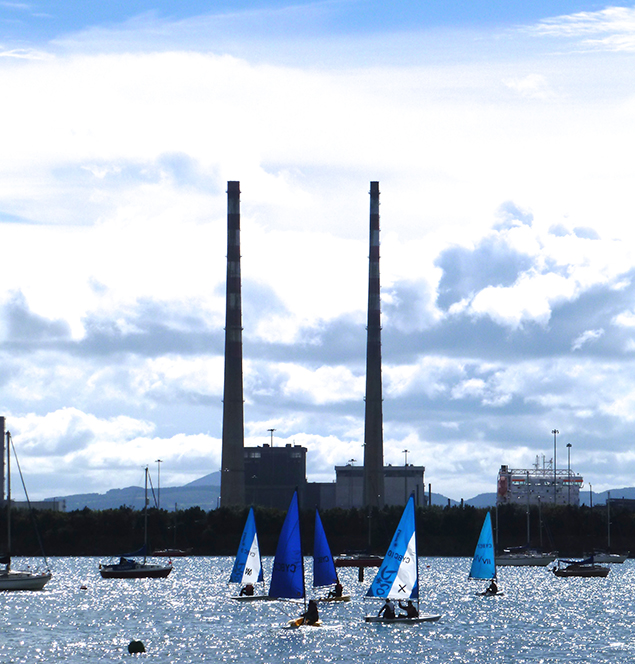 Clontarf Y & BC’s formerly clear view to the Wicklow Mountains is now somewhat interrupted, but the junior squad can still get in their training session afloat before the IDRA 14 fleet takes over the sailing water. Photo: W M Nixon
Clontarf Y & BC’s formerly clear view to the Wicklow Mountains is now somewhat interrupted, but the junior squad can still get in their training session afloat before the IDRA 14 fleet takes over the sailing water. Photo: W M Nixon
Over the years the clubhouse acquired some embellishments to become more pavilion-like, and what had been little more than a coastal path in front of it became almost roadlike as the built waterfront extended eastward. But thanks to the enormous presence of Lord Ardilaun’s St Anne’s Park estate further along the shore at Dollymount, the main road out to Howth continued to be the old post road going well inland through Raheny.
However, inevitably in time the James Larkin Road was created along the shore at Dollymount to provide a more direct main road to Howth, with traffic increasing year on year until now it seems to rumble by in a continuous stream between Belvedere and the sea.
In the circumstances, any club which wasn’t such an integral part of its community might well have considered re-location. But Clontarf Yacht & Boat Club is very much local and community-based, and it has adapted instead, even becoming accustomed to the fact that much of its once flawless view across the bay to the hills and mountains is now interrupted by the expansion of Dublin Port, with the latest addition to the intermediate skyline being the monumental new incinerator rapidly taking shape across in Ringsend.
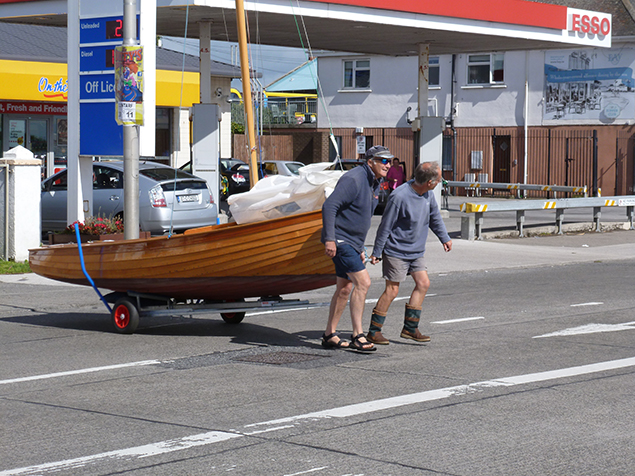
Yet if it’s a half decent sailing day, and the tide is flooding, Clontarf leaps to sailing life. On Sunday afternoon when the good weather mercifully lasted much longer than predicted, the place was buzzing not only with good-humoured aficionados of the IDRA 14 Class celebrating their boat’s 70th birthday, but with a host of trainee juniors who got in their sailing session before the fine fleet of historic IDRA 14s took over the stage for their concluding review of the fleet parked in line along the green, in readiness for launching and rounding out the celebrations with a Parade of Sail afloat mostly close along the waterfront, something which was most easily organized simply by making it a race.
Throughout it all, Sunday walkers and locals of every speed and type moved along Clontarf’s fine promenade mingling with the boats and boat people and everyone – whether sailors or not – seemed to know everyone else, or at least felt they did, while the multiple presence of cheerful dogs of all shapes and sizes improved things even further.

As to the business of getting your boat out of the dinghy park and across that busy road to the slipway, former Clontarf Y & BC Commodore Ian Sargent demonstrated the technique to perfection: “You just step out slowly, you’ll find the traffic starts to slow down, then as they see what’s going on they’ll come to a stop if need be as you walk across in confident but unhurried style. Then as you get safely across, it is absolutely imperative that you wave your thanks to all involved”.
It was primarily thanks to Ian Sargent and his tolerant wife Rebecca that last weekend’s celebrations took place. He is the total IDRA 14 nut, lovingly researching and recording the history of every boat back to that immediately post-war time of precious hope, but little else, in 1946. Back then, far-sighted people like Douglas Heard and Billy & Jimmy Mooney in Dun Laoghaire in November 1945 set in train the movement which became the Irish Dinghy Racing Association, and in so doing they reached out to other clubs nationwide in mutual support with fellow-enthusiasts.
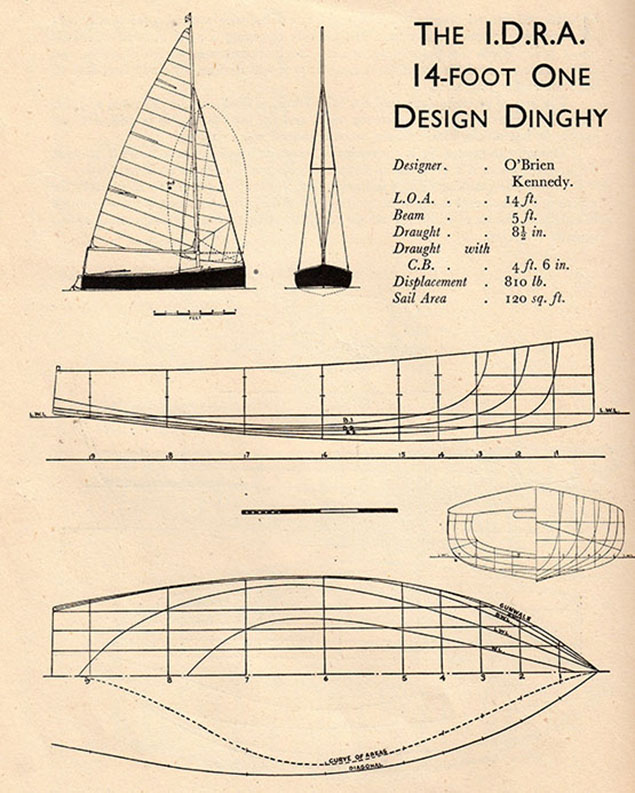 The IDRA 14 as first publicised in 1946. Within weeks, 46 boats were under construction by bot professionals and amateurs.
The IDRA 14 as first publicised in 1946. Within weeks, 46 boats were under construction by bot professionals and amateurs.
The flagship of the new Association became the IDRA 14, developed from a design by an Irish naval architect working in England, George O’Brien Kennedy. His period of working across the water was later fondly recalled by fellow yacht designer David Thomas, who used to say that Brian – as everyone knew him – would come up with more innovative boat ideas in a morning than the rest of the office produced all week.
Admittedly some of his ideas were frankly crazy. But in developing the design of the clinker–built IDRA 14 from a boat he’d designed for his own use in 1938 but whose possible expansion as a class was stymied by World War II in 1939, he produced an eminently sensible design which not only suited Irish needs at the time, but was also later successfully used in slightly modified form at three English sailing centres.
One of the clubs which immediately embraced the new Irish boats with huge enthusiasm was Clontarf Yacht & Boat Club, and it has remained such a stronghold of the class that the very newest IDRA 14, Wicked Sadie number 166, was timber built in classic style in a shed out the back of the club by a team co-ordinated by Rowan Melling, a two year project which reached it successful conclusion to considerable acclaim with Sadie’s Gala Launching at Clontarf on June 25th 2016.
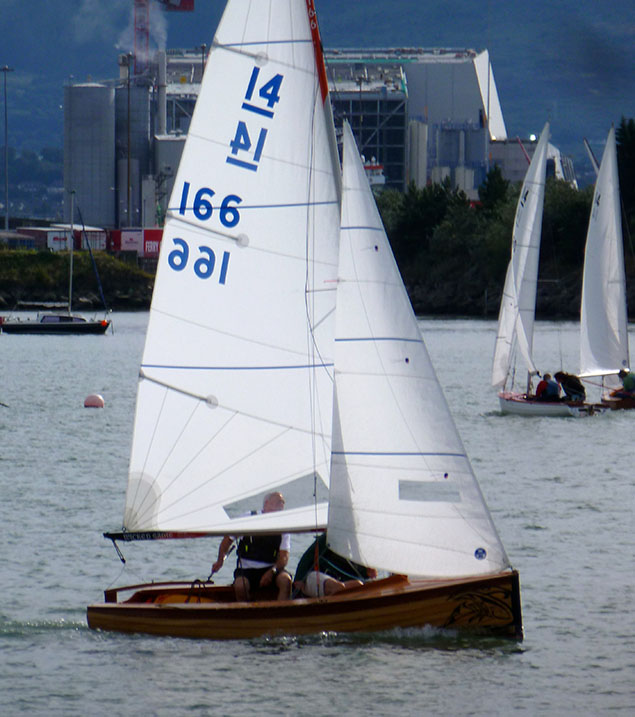 They’re both the newest things in town. The IDRA 14 Wicked Sadie was first launched on June 25th 2016, and beyond her is the newest part of the national infrastructure, the Ringsend Incinerator. Photo: W M NixonThe very first boats were built nearby in 1946, just across the Tolka Estuary from Clontarf in Jem Kearney’s boatyard at Dublin’s East Wall. A brother of the noted yacht designer and builder John Kearney, Jem was something of a rough diamond, but those who worked with him or learned something of the skills from his boat-building classes thought very highly of him and his work.
They’re both the newest things in town. The IDRA 14 Wicked Sadie was first launched on June 25th 2016, and beyond her is the newest part of the national infrastructure, the Ringsend Incinerator. Photo: W M NixonThe very first boats were built nearby in 1946, just across the Tolka Estuary from Clontarf in Jem Kearney’s boatyard at Dublin’s East Wall. A brother of the noted yacht designer and builder John Kearney, Jem was something of a rough diamond, but those who worked with him or learned something of the skills from his boat-building classes thought very highly of him and his work.
There isn’t the space here to detail the way the early sail numbers were allocated, as 46 boats were soon in various levels of construction – both by professionals and amateurs - from an early stage, and each club group which had signed up to the new class was given a batch of numbers with the boats getting afloat in random order.
Thus the first boat in commission was actually Number 14, Deirdre built by Jem Kearney for that renowned sailing cleric, the Reverend George Good, whose exuberant approach to life suggested that he might have felt much more at home in one of the livelier periods of the 18th Century. As to Deirdre, she almost immediately became a mystery which still hasn’t been explained to this day. All we really know is that in due course George God appeared with another new IDRA 14, but this time built by Walter Levinge of Athlone, yet still sporting sail Number 14 and still called Deirdre.
Meanwhile other boats were appearing in much more orthodox style in rapid succession, with Number 1 being built by Kearney for Douglas Heard himself, though quite why he called her Error we can only guess. But whatever the reason, she won the first championship in 1947, and she’s still gong strong and was at the Clontarf celebrations in the proud ownership of Jim Lambkin of Sutton Dinghy Club.

Next in line numerically at Clontarf on Sunday was a boat which has more than a few connections with this parish, but we’ll come to that anon. No 4 Dusk was another 1946-built Jem Kearney boat whose first owner was Hugh Allen, who went on to crew for Alf Delany in the Swallow Two-Man class in the 1948 Olympics, sailing in the first-ever Irish Olympic Sailing Team.
In return, Alf Delany then crewed for Hugh in Dusk in the 1949 IDRA Championships at Crosshaven at what was then the Royal Munster, and they won overall. This staging of an event at Crosshaven was a great boost to the class’s development in Cork, and the local firm DBL – Driscoll, Bushe & Leonard, with George Bushe and Dick Leonard the main partners – became much involved with their construction.
But Cork owners were as canny then as they are now, and in 1950 Crosshaven sailing brothers Barry and Harold Cudmore ordered a new IDRA 14 from George Bushe on condition that he’d won the nationals with her. George was as good a helmsman as he was a boatbuilder, so he cheerfully took up the challenge, built the boat, signed up the legendary Kevin O’Regan as crew (see Afloat obit) and off they went to the 1950 Nationals at Dromineer. And they duly won, which left the Cudmore brothers with boat now called Monaveen, and a very high standard of performance to maintain.

Histories of Ireland in the late 1940s and on through the 1950s paint the picture of a nation in total economic stagnation, yet the IDRA 14 class so captured the Irish sailing imagination that these became the class’s special years, good times which extended on into the early 1960s, for in 1960 the class had up-graded itself by permitting synthetic sails and adding a trapeze for zippier performance in a breeze.
The list of sailors who got involved with the IDRA 14s in these boom years reads like a Who’s Who of top Irish sailors, as people of the calibre of Douglas Heard, Jimmy Mooney, Hugh Allen, Jem Sullivan, Charlie Sargent and Peter Odlum were to be joined by the Cudmore clan, Denis Doyle, Conor Doyle, Joe Fitzgerald, Mick Sullivan, Ted Crosbie, Ian Morrison, Liam McGonagle, Desmond Keatinge, Bunny Conn, Roy Dickson, Dougie Deane, Jackie O’Reilly, Johnny Vaughan, Sid Shine, Philip Jacob, John Millar, John Godkin, Sean Flood, Clayton Love Jnr. and many others.
Crosshaven’s own Clayton Love Jnr’s involvement was undertaken with typical thoroughness, as he’d had George Bushe build him Miss Betty (IDRA 14 no 54) in 1949 with all those special skills which George Bushe could bring to a winning boat which was also a work of art. Then Clayton gave the IDRA 14 Class six years of his enthusiastic attention, winning just about everything with the Cork fleet, and taking the national title twice, in 1953 at Crosshaven, and 1955 at Dunmore East, crewed by Donal McClement in ’53 and Hugh Barry in ’55.
He then sold the boat on to Sean Flood of Clontarf, who in turn won the Nationals with her at Wexford in 1958 and Ballyholme in 1959. But by this time what had been Ireland’s premier dinghy class for a dozen years was beginning to feel the pinch as newer designs came forward, and several of the top IDRA 14 people moved into the exotic realms of the International 505 Class, which in Ireland became a sort of moveable feat, an elite group of upwards of a dozen top dinghy talents who might deign to take part in the annual IDRA Dinghy Week, but equally they might descend with their own road show on select places such as Dromineer on Lough Derg, where their activities afloat and ashore became the stuff of legend.
But while the exotic heights of the 505 class were all very well for those who could afford it, the solid citizens of the IDRA 14 class were determined to keep their much-loved boats as a viable racing option at both club and national level, and during the 1960s the contribution of the Sargent family to the class’s continuing health was remarkable.
The patriarch of the clan, Charlie Sargent, was general manager of timber merchants T & C Martin, so there were few people in Dublin who knew more about wood. But in his spare time, he was also a boat builder whose skills were way beyond those of many professionals, and near the family home firstly in Clontarf, and later in Sutton, he produced masterpieces of the boatwright’s art and craft.
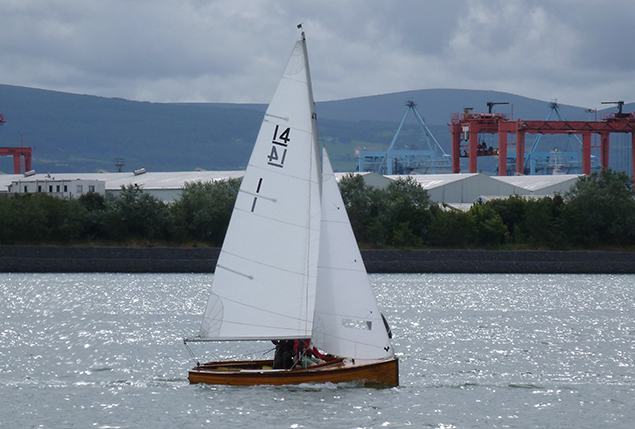
He’d been involved with the IDRA 14s as both builder and owner since 1946, but it was in 1962 in Sutton, working with his son Gerry, that he built what many would reckon to be his masterpiece, no 38 Starfish. With her combination of clear spruce planks and a beautiful mahogany sheerstrake, for appearance Starfish has become the definitive IDRA 14 by which other boats are rated. And she soon proved herself a winner too – in 1963 Gerry Sargent, crewed by his brother Ian, won the Nationals at Skerries with her.
By this time the class had to face off another challenge, the increasing popularity of glassfibre construction for new dinghy classes, and here too the Sargent family played a key role in moving things forward. Much and all as Charlie Sargent loved building boats in classic style in wood, the class eventually persuaded him that they desperately needed a fibreglass hull option if they were to continue moving forward. Having accepted this, Charlie Sargent gave it his full support, and he built the plug for the mould for the new GRP hulls which were made by Delcraft of Malahide.
Then he and his family finished the bare hull with the deck and other wood trim to have her racing under Ian Sargent’s command as Sea Urchin 3 (later Swift, no 114) in the 1977 season, and by 1979 they had the GRP boats up to speed, with Ian winning the championship at Lough Ree.
The continuing health of the class then found another option in 1993 when the restored Dusk (no 4) was one of the star exhibits at the Dublin Boat Show. She’d been mouldering since 1978, but was brought back to classic life by Tom O’Brien and his son David, editor of Afloat Magazine, in a project with WEST System agents Waller & Wickham which showed that epoxy saturation techniques worked very well in restoring vintage IDRA 14s. A number of specialist firms were involved in the Dusk project, with Alistair Duffin of Belfast (best known as the top International GP 14 builder) installing the deck, centreplate casing and the thwarts in the bare hull as finished by the O’Briens, while Wicklow Marine Services were in charge of the final stages.
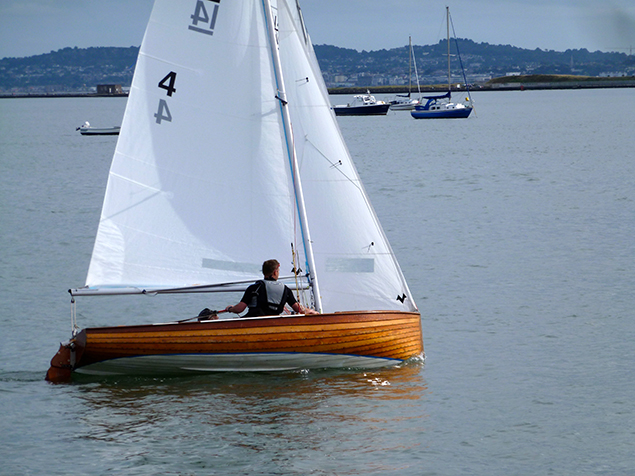 Originally built for Olympic sailor Hugh Allen in 1946, Dusk was restored in 1993 by Tom and David O’Brien in a demonstration of the potential of the WEST method. She placed second in Sunday’s 70th anniversary race. Photo: W M Nixon
Originally built for Olympic sailor Hugh Allen in 1946, Dusk was restored in 1993 by Tom and David O’Brien in a demonstration of the potential of the WEST method. She placed second in Sunday’s 70th anniversary race. Photo: W M Nixon
 "A page from Afloat Magazine for January-February 1993, the photo showing Tom O’Brien with the restored bare hull of Dusk being weighed as part of the stringent measurement rules of the IDRA 14 Class and below a cutting from the April 1993 issue shows Dusk did indeed make it for the Dublin Boat Show in March
"A page from Afloat Magazine for January-February 1993, the photo showing Tom O’Brien with the restored bare hull of Dusk being weighed as part of the stringent measurement rules of the IDRA 14 Class and below a cutting from the April 1993 issue shows Dusk did indeed make it for the Dublin Boat Show in March

David O’Brien had a successful year racing Dusk, taking the runner-up slot in the Nationals in 1993 at Carlingford to the evergreen Starfish (Terry Harvey, Sutton). Subsequently he moved into Fireballs with John Lavery with such success that by 1995 they were World Champions, but Terry Harvey went on to reap continuing success with Starfish in the IDRA 14s, with more championship wins than anyone else.
However, others have got in on the act, and the milestone of a first woman champion was reached by Scorie Walls of Sutton racing Chance (no 163) at Galway Bay in 2000, and she retained the title the following year at Lough Ree racing Starfish. As for the first all-female crew to take the title, that came in 2012 on Lough Erne when Julie Ascoop of Clontarf crewed by Heather Keenan won in Chaos.
The rich texture of the class’s history over the years has always been something to celebrate, and it was very special when O’Brien Kennedy himself turned up to be the Guest of Honour at the Golden Jubilee in 1996. The golden thread of the storyline in Ireland has been further reinforced by developing contacts with the sole remaining class of sister-ships, the Dragonflies at Waldringfield in Suffolk in the east of England on the lovely River Deben.
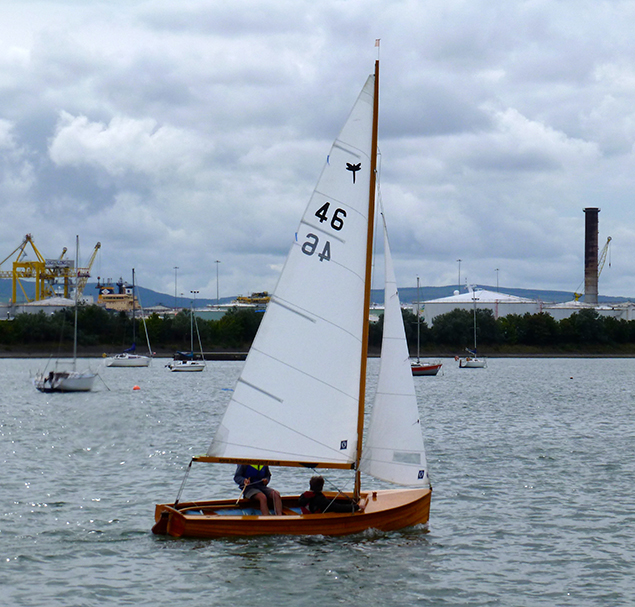

The Dragonflies were founded in 1949, so when their 70th birthday comes along in 2019, a strong contingent of IDRA 14 sailors will be descending on Waldringfield and doubtless putting much business the way of the famous Maybush Inn as well as the bar of Waldringfield SC. But meanwhile the news from Suffolk was that classic boat enthusiast James Palmer, a former engineer but now born-again traditional boatbuilder, had just built the newest Dragonfly in classic style, so Ian Sargent set to work persuading him and ten of his fellow club members to come to Ireland for last weekend’s party at Clontarf, bringing the new boat Phoenix with them. It all came together in time, and there we were last Sunday in sunny Clontarf with upwards of thirty IDRA 14s of all vintages lined up along the promenande, with the new Wicked Sadie and the new Phoenix in pride of place, when the magic ingredient was added.
Clayton Love Jnr, IDRA 14 Champion in 1953 and 1955, and Sean Flood, IDRA Champion in 1958 and 1959, turned up to wish everyone well and inspect the fleet and then see the Parade of Sail, which already had all the makings of a good race.
But we’d to wait a while for it, for it seems that once you’re an IDRA 14 man you’re always an IDRA 14 man, regardless of the many famous boats with which you’ve been subsequently associated. So the two legends of the class’s history took their time in inspecting the fleet, having a particularly long chat with Jim Lambkin with Error, the boat with which Douglas Heard won the first championship in 1947.
The links with the past were then completed with the arrival of Shane O’Brien Kennedy, son of the late designer, who was soon fitted up with a berth for a race in which the Dragonfly visitors from Waldringfield were also spread through the fleet.
James Palmer himself raced Phoenix in what seemed at first a slightly unfair match, as the Waldringfield class have adhered strictly the their original 1949 specification, including wooden spars and traditionally-shaped sails, whereas the IDRA 14s have long since been into alloy spars with a rig as souped-up as it can be, with most of the top boats now setting sails made by Dick Batt, though it was very evident that Wicked Sadie has preferred North.
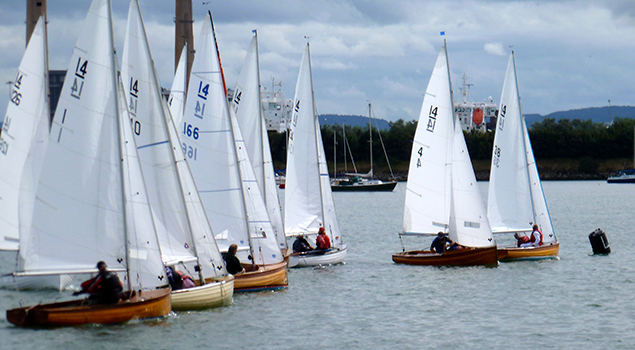 Seconds to go to the start….Gerry Sargent in Starfish (38) is exactly where he wants to be, and so too is Neil Cawthorn with Dusk (4). Photo: W M Nixon
Seconds to go to the start….Gerry Sargent in Starfish (38) is exactly where he wants to be, and so too is Neil Cawthorn with Dusk (4). Photo: W M Nixon
But handsome is as handsome does, and there was no avoiding the imperatives of history. Shaping up for the start, Gerry Sargent sailing Starfish with Ian McCormick as crew was right there on the pin to keep himself on the left hand side of the first beat. Neil Cawthorn of Waldringfield with Andy Sargent on Dusk nipped past his stern on port but clear across the rest of the fleet still on starboard.
Most of them were keen to get onto port as soon as possible for the traditional win move along the Clontarf wall in the very last of the flood, with no lack of useful advice from helpful promenadeers within yards of them. But out on the left was the place to be, and Gerry Sargent scrunched Starfish up to the mid-river line of breeze at every opportunity, sailing in clear wind when fleet numbers meant that few other boats always had clean air, and Starfish had a fine lead from Dusk at the first mark.
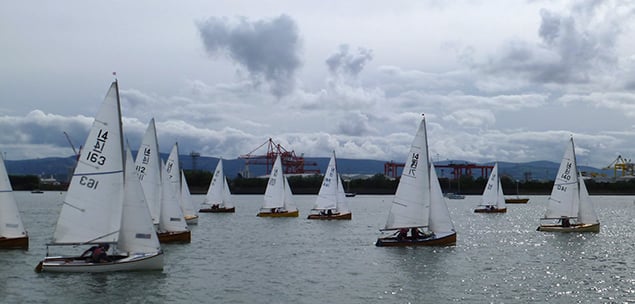
The wind lightened in the two long reaches to take in the south mark, and by the time the leaders were approaching the lee turn down toward the Royal Dublin Golf Club, the ebb had started as Gerry Sargent came round the mark with an enormous lead, and still next in line, and now equally clear of the boats behind, was Dusk, while in the midst of the tail-enders was Phoenix, feeling very far from home in the green fields of Suffolk.
But once the ebb starts running at Clontarf, it doesn’t hang about. It fairly sluices along the promenade and over the Clontarf slip, swirling towards the North Bull Wall. Yet having been so far ahead, Starfish had much less of this adverse tide, which only increased her enormous lead and she was able to work along the shore using the slightly better breeze there nearing the finish, as too was Dusk, though by now quite some time later.
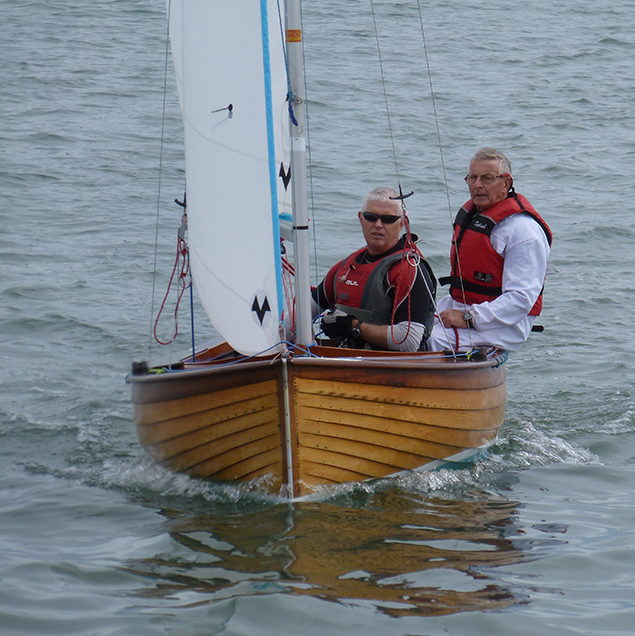
But the rest of the fleet were getting in each other’s way hoping to find an eddy right inshore east of the slip. It was their undoing. James Palmer sensibly kept himself clear of this melee, and sought the new breeze out towards the middle. It paid off big time. Phoenix went from crab grass to contender in that final beat, and finished sixth with dozens of supposedly hotter boats well behind her.
 Promenade racing. Dusk closing in on second place, with the Royal Dublin Golf Club in the background. Photo: W M Nixon
Promenade racing. Dusk closing in on second place, with the Royal Dublin Golf Club in the background. Photo: W M Nixon
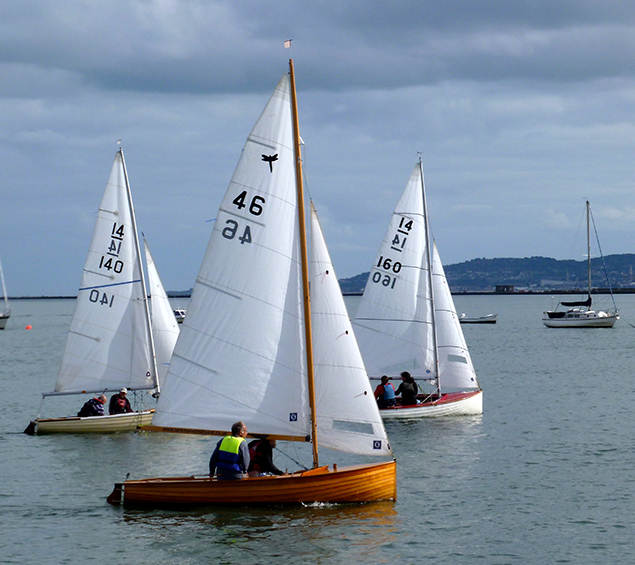
It was a fairytale ending to a magic day. The winner was the most beautiful boat in the class, sailed by a man who built this most beautiful boat with his father 54 years ago. Second place was filled by the boat which won the championship in 1949, a boat which, in this year of Irish Olympic sailing medals, gives us a direct link back to that very first Irish Olympic team of 1948. She is also the boat which, in 1993 in another father-and-son project, showed what can be done to keep a classic IDRA 14 in good order through the newest techniques. And in a very honourable sixth place, there was a visitor who had come a long distance in many ways in order to join the IDRA 14 class in celebrating their 70th birthday.
It was a day to remember and cherish, so here’s the list of the top six: 1st Starfish (1962, sailed by Gerry Sargent); 2nd Dusk (1946, sailed by Neil Cawthorn); 3rd Siobhan (1979, sailed by Louise McKenna); 4th Delos 2 (1953, sailed by Derek Jacobs); 5th Slipstream (1978, sailed by David Rowland), 6th Phoenix (Dragonfly, 2016, sailed by James Palmer).
And if you’re minded to absorb further the special nature of the IDRA 14 Class, this video below from the 1950s which Lough Derg YC presented to the class when they held their 2016 Nationals down there three weeks ago, the winners being Alan Henry and Simon Revill from Sutton.



























